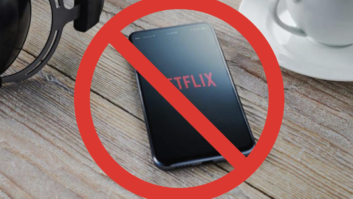
The recently ratified High Efficiency Video Coding standard should deliver up to 50% bitrate savings compared to H.264 for HD, and will work particularly well at higher resolutions and frame rates. While rollout to consumers could take several years, it is a real prospect for use for contribution in the next year or so, where it would be particularly useful for news over 3G/4G or portable satellite links. For example, Telestream has demonstrated “serviceable 500Kbps HD footage with HEVC which looks better than 1Mbps H.264. This translates to significant CDN and satellite savings,” said its Director of Product Marketing, Enterprise Products, John Pallett, and he thinks that 1Mbps HEVC “will offer a great HD experience.” Rovi’s VP Technology, Eric Grab, believes that there are a lot of interesting applications for HEVC in contribution. “Anywhere people find the network already saturated. It’s going to become mainstream pretty quickly.” However, there are a few hurdles to overcome before HEVC is deployed in the field. “If bandwidth limitation is a large constraint, then HEVC delivers a lot of what you are looking for,” said Motorola Mobility’s Home product architect, EMEA, Mike Gannon, “but for contribution there are considerations of latency and speed of encoding.” “HEVC will be used first in applications where bandwidth is a problem today and the client device will easily be updated to support HEVC, either because it is a device that users replace frequently (smartphone) or because it is flexible to support HEVC as it is (PC). This means OTT delivery of live and on demand content, especially over wireless networks, is likely the first economically viable use case,” said Benoit Fouchard, Chief Strategy Officer, ATEME. “Contribution applications will come later, and require more robust a complex implementations of the standard than what can be offered by compression vendors at this time,” he added. However, Mike Nann, Director of Marketing and Communications, Digital Rapids, sees contribution as an ideal application for the new standard. “Contribution may be able to adopt HEVC relatively quickly (compared to distribution applications) as they can be implemented with encoder/decoder combinations under specific interoperability constraints and transported even over proprietary protocols, reducing the need for compatible device proliferation and standardization,” he said. Contribution “is one of the first areas the new standard can target, whether point-to-point or point-to-multipoint, as it is generally in control of the broadcaster, so the cost implication of a single receiver is very different to millions of set-top-boxes. But, one thing that will delay it is the lack of contribution specific support in the standard at the moment,” such as 4:2:2, said Fabio Murra, Head of Portfolio Marketing, Compression, Ericsson. These features may not be ratified until 2014, but once it is he feels HEVC “will be adopted pretty quickly.” Eric Gallier, VP Marketing, Thomson Video Networks, agrees that, first, we need a standard for contribution applications. “In January 2013, the standardization body agreed on 4:2:0 profiles only. There is discussion today to expand the standard to 4:2:2 profiles that are more suitable for contribution applications. This should happen before the year end,” he said. “Secondly, we’ll probably need hardware implementations for those new profiles and for both the encoder and IRD to reduce footprint and power consumption. Most contribution applications also require low latency for interviews: 4:2:2 and 10-bit at least.” “On the contribution side, HEVC still does not have a fully standardized 10-bit colour depth with 4:2:2 sampling profile (4:2:2 support for Main 10 profile is expected to be ratified in 2014),” agreed Nikos Kyriopoulos, Product Director, Media Excel. “Once this is done, it will be up to specific use-cases to adopt HEVC in contribution. For example, point-to-point contribution, where a dedicated encoder-decoder pair is utilized, is more likely to be adopted first rather than a point-to-multipoint one where typically an encoder is asked to interoperate with an ecosystem of third-party decoders and IRDs. Similarly, IP-based contribution networks are likely to adopt HEVC first rather than ASI/Teleport-based ones, as Satellite-based contribution will take longer to support HEVC workflows (even though the cost savings there are generally more attractive, the switching cost is also significant).” “Contribution is an ecosystem, in which interoperability is mandatory,” said Fouchard. “A lot of international sports transmissions involve multiple players, who may be using multiple vendors for encoders and decoders. The industry needs a choice of proven and interoperable products from multiple vendors before making a move. If we compare with MPEG-4 adoption, it started being used for IPTV in 2005, then for DBS, and became mainstream for contribution only from 2010, so almost five years after early adoption in IPTV.” Fouchard expects this cycle to be shorter for HEVC (three to four years), which would see the new standard become mainstream in 2017 or 2018. However, in a survey Elemental conducted in late 2012, nearly two thirds of respondents said they would like to test HEVC in the first eight months of 2013. “And at NAB this year, we couldn’t give enough demonstrations of our realtime HEVC [1080p] encoding demonstration,” said its VP of Marketing, Keith Wymbs. “Decoder chipsets for HEVC are being developed far quicker than was the case for MPEG-4 / H.264. Early availability of silicon is expected later this year with limited STB / Integrated Screens beginning to emerge in 2014,” said Ian Trow, Senior Director Emerging Technology & Strategy, Harmonic. “The ProMedia Live product was announced at NAB 2013 for HD HEVC live applications, so product is beginning to emerge,” he added.“In terms of contribution, the HEVC standard has not been finalized for this application, although it is a planned second phase standard development for HEVC. There has been speculation that the HEVC standard doesn’t offer enough bandwidth saving for contribution applications in their sweet spot of operation (ideal window of use: bit rate). As with the adoption of MPEG-2 and MPEG-4 for contribution, any adaption of the HEVC standard will have to justify itself by offering a sensible alternative to existing or new solutions in terms of performance and cost,” added Trow. “The primary piece missing is decoding capabilities. Encoding is starting to appear for VoD content and will soon be available for live content as well. After that… it depends upon which type of network you mean, and whether you are talking about live or VoD content,” said Pallett. The choice to use HEVC for contribution is a value proposition against existing MPEG2/4 solutions, “as well as stacking up against acquisition compression standards like AVC-I and JPEG2K which have the advantage of editability and cutting out workflow steps in the production process,” said Trow, although some of the respondents believe that HEVC could itself become a good editing codec. Although HEVC is seen as the perfect codec for Ultra HD, H.264 is still expected to be the codec of choice for 4K contribution, “at least initially, especially over DVB-ASI/Teleport-based networks where H.264 is ubiquitous (fully supports 4:2:2 sampling, etc.). This applies to distribution scenarios as well, as long as the use-case justifies the elevated transport costs,” said Kyriopoulos. Ericsson, for example, is working on trials with the EBU and KT Skylife in Korea to transmit/contribute Ultra HD using H.264 “One of the main drivers [for Ultra HD] will be sporting events. AVC already allows this and has the 4:2:2 progressive 10-bit formats necessary” said Murra. Ericsson has adapted its Simulsync technology, developed for 3D, to synch the four HD quadrants of the picture together to transmit Ultra HD. “One other aspect that also makes good sense in sports specifically is the utilization of the 4K frame as a canvas where HD frames are produced from. Essentially, allowing for 4K contribution content to be cropped (zoomed where the action/ball is) into an HD frame for delivery with AVC/H.264 compression,” said Kyriopoulos. This article is an addition to the two-part feature on HEVC that will appear in the May and June issues of TVBEurope. David Fox







